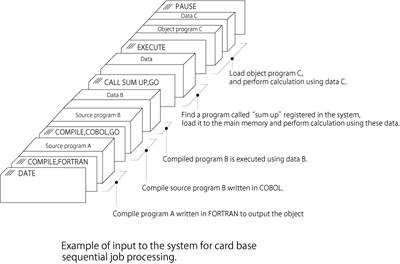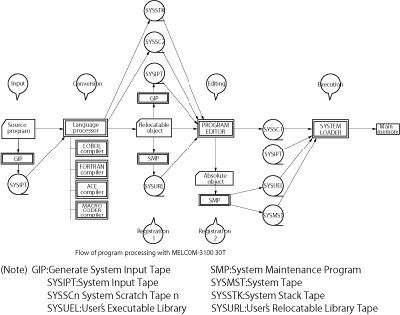For Mitsubishi Electric's MELCOM-3100 series announced in 1966, Model 10T operating system, Model 10PT operating system and Model 30T operating system were provided. These operating systems used magnetic tapes as external storage and were developed by systematically organizing and enhancing the system programs built up with MELCOM-1530.
1. Model 10T operating system
The Model 10T operating system was based on card input, and the corresponding standard hardware consisted of a main memory with the capacity of 24K characters, a typewriter, a card reader, a card punch, a line printer and 4 to 8 magnetic tape devices. The system was operable without a card punch.
The operating system comprised a control program and processing programs. The control program was the core of the operating system, consisting of a system supervisor, a job processor and a debugging routine. These elements were responsible for tasks such as reading and writing programs and data between memory and devices, controlling program executions, processing interrupts and abnormal events, processing jobs and communicating with operators. The processing programs included compliers of languages such as COBOL and FORTRAN, a MACRO-CODER, an assembler, utility programs including SORT and MERGE, and application programs such as LP and PERT. User-created programs were also included amongst the processing programs.
As indicated in the figure, a source program was read from a card reader or a magnetic tape, converted into a Primary Object Program by a compiler or an assembler, written to a card or magnetic tape, and then read by a loader called PL (Primary Loader) and executed. It was also possible to register in advance repeatedly used programs in a program library (in a magnetic tape) by converting them into Secondary Object Programs using SMP (System Maintenance Program), and later read the desired program using a loader called SL (Secondary Loader) and execute it. In converting a card to a magnetic tape, JPP (Job Preparation Program) was used. To achieve a compact configuration, a function for editing object codes was omitted and object codes were created in absolute format.
The Model 10T operating system was based on card input, and the corresponding standard hardware consisted of a main memory with the capacity of 24K characters, a typewriter, a card reader, a card punch, a line printer and 4 to 8 magnetic tape devices. The system was operable without a card punch.
The operating system comprised a control program and processing programs. The control program was the core of the operating system, consisting of a system supervisor, a job processor and a debugging routine. These elements were responsible for tasks such as reading and writing programs and data between memory and devices, controlling program executions, processing interrupts and abnormal events, processing jobs and communicating with operators. The processing programs included compliers of languages such as COBOL and FORTRAN, a MACRO-CODER, an assembler, utility programs including SORT and MERGE, and application programs such as LP and PERT. User-created programs were also included amongst the processing programs.
As indicated in the figure, a source program was read from a card reader or a magnetic tape, converted into a Primary Object Program by a compiler or an assembler, written to a card or magnetic tape, and then read by a loader called PL (Primary Loader) and executed. It was also possible to register in advance repeatedly used programs in a program library (in a magnetic tape) by converting them into Secondary Object Programs using SMP (System Maintenance Program), and later read the desired program using a loader called SL (Secondary Loader) and execute it. In converting a card to a magnetic tape, JPP (Job Preparation Program) was used. To achieve a compact configuration, a function for editing object codes was omitted and object codes were created in absolute format.




